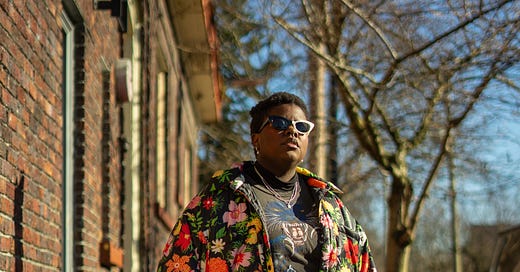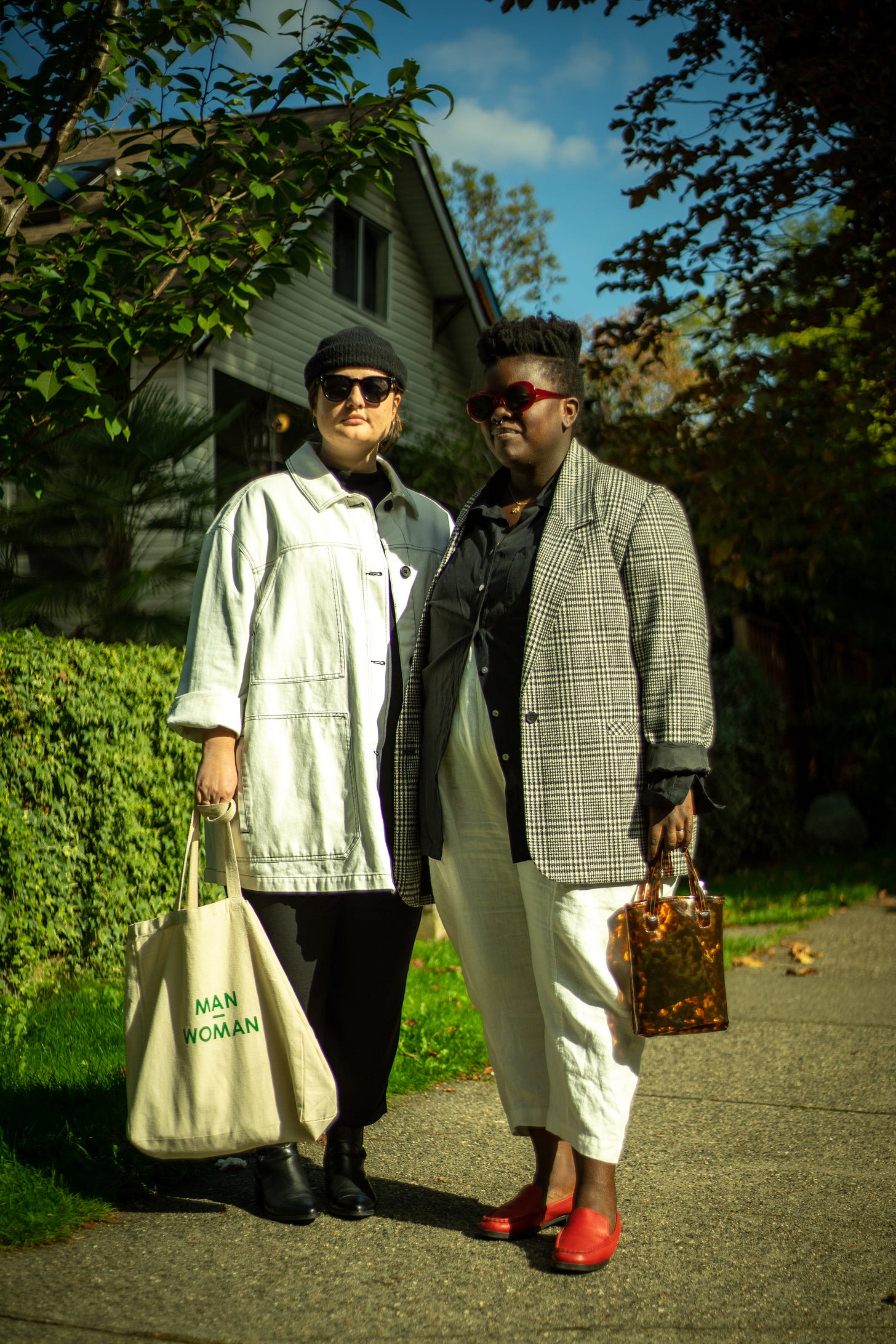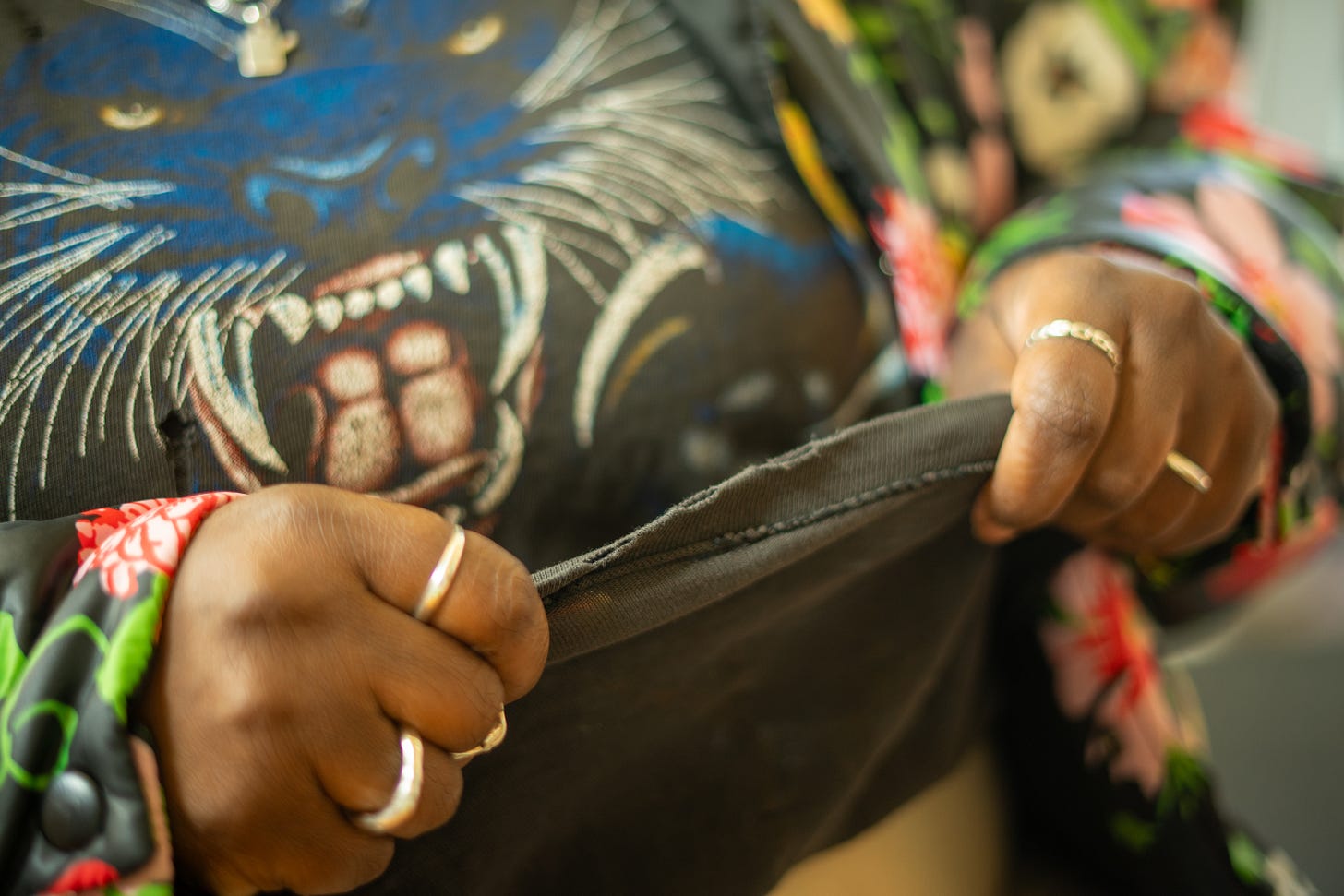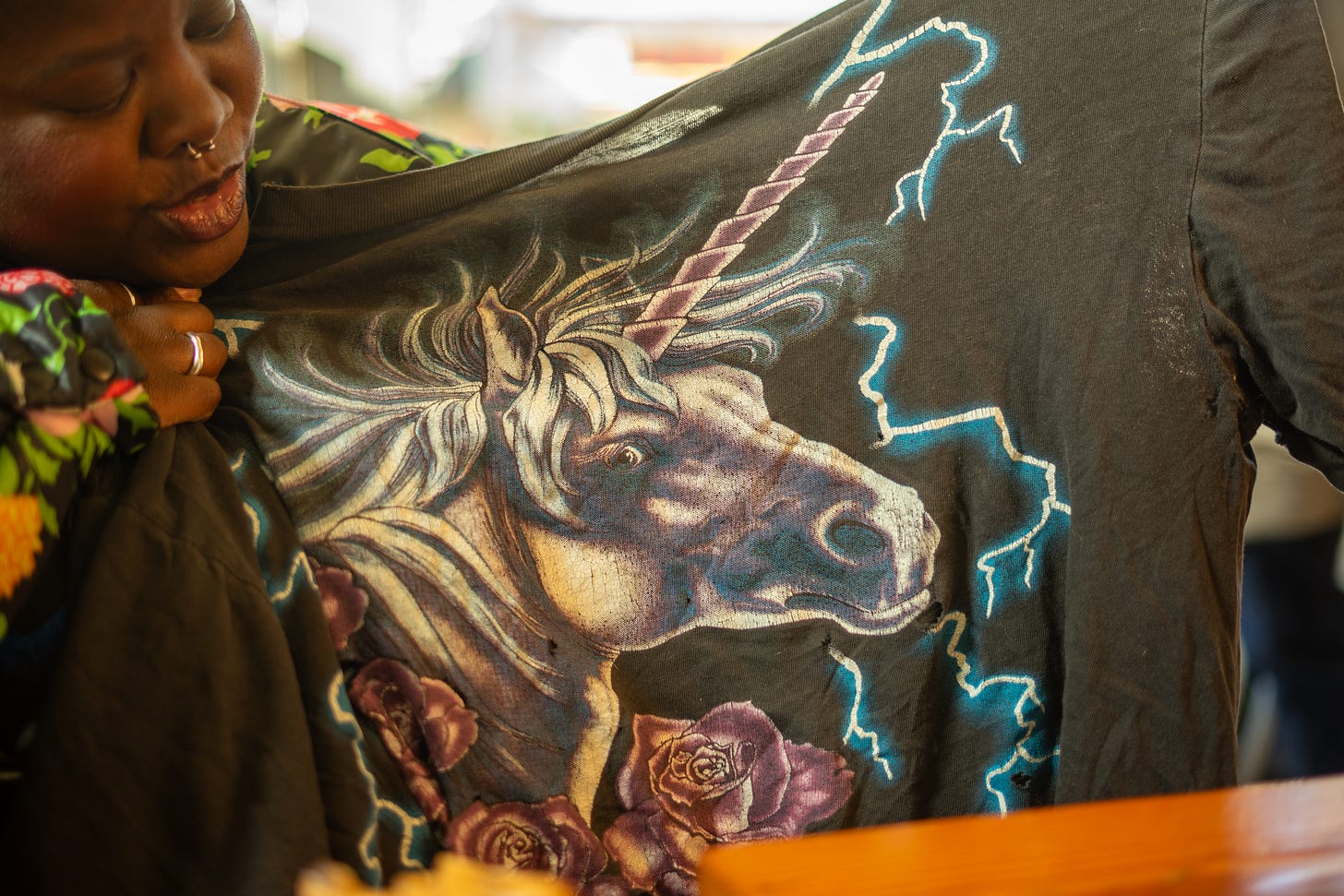GENES #7 - Lydia Okello
An interview with Vancouver fashion influencer, writer, model, and vintage connoisseur, focused on their favorite t-shirt, ever!
This is the 7th installment in my series called GENEs where I interview locals I have met over my time taking photos in “east vancouver” and unravel the stories behind their favorite things.
To check out the previous interviews covering a range of clothing with gorgeous stories, see the link here.
To ensure you don’t miss an interview, consider subscribing now.
The introductions to this series are following the same pattern; I meet interesting people while taking photos for SoEV, I end up following them on Instagram for a while, and make connections every so often, which has then led me to reach out and ask them to do a GENEs interview…
This introduction is no different than the rest, however, Lydia was the first name that a few people dropped when I asked “who in the city should I interview for this series?”.
Lydia’s influence in the style space obviously runs deep in “Vancouver”.
The photo below is the first time I took a photo of Lydia with their partner walking down 10th Ave. on a crisp fall day in 2019. It will always be one of my favorite photos in the seasons portfolio. Their opposite coordinating outfits, the iconic late fall “east van” greenery framing the photo, the perfect midday light, with slight pops of colour in Lydia’s outfit, and of course a “statement” tote bag, all pieces indicate a very, very, “vancouver” photo.
Since that day, I have followed Lydia’s Instagram page where they continuously explore clothing and fashion from multiple angles including sustainability, gender-fluidity, and size-inclusivity, drawing their audiences attention to brands which are addressing these topics and pushing the notion that, although there are pockets of change, progress still needs to be made. They have written articles for Vogue and FASHION, are always creating and active on TikTok and Instagram, and continue to push my own understanding of what it means to get dressed.
I see Lydia around the neighborhood often, they are one of those people that are always fitted. I have to often talk myself down from running across the street to snap a picture; I try to not bug the same people repeatedly, but it’s hard when they display a constant variation of outfits and blend functionality with style so effortlessly, mixing and matching pieces to always look fresh.
I reached out even before it was suggested to interview Lydia and was so pleased when they agreed to meet me for a coffee to do this interview. Luckily it was a crisp winter morning and we met to talk everything style while we enjoyed a coffee and “cookies with no name” at Prado on Commercial.
Influencing History
Since I had the opportunity to have a one-on-one conversation with Lydia, I decided to start the conversation asking a bit about their history in the blogging/influencer space, specifically about writing, to gain an understanding of how they got to where they are today.
I had read many of their publications leading up to this interview, so I was mainly focused on how they’ve carved a path in this competitive and niche industry. Lydia started by telling me a bit about their first blog they began writing while in high school in Abbotsford, focused on clothing:
The blog was such a great outlet because I was really interested in aesthetics, vintage fashion, thrifting and simply being able to express yourself through personal style. I didn't have peers in real life who had that perspective. So that was kind of my way into the [“industry”] in 2008, being a part of different online communities.
Finding this peer space online helped to alleviate some of the isolation they felt at a high school that was very different in the values, perspectives, and style choices Lydia wanted to explore during those formative years. Writing and interacting with these online communities led to working in the vintage clothing industry, picking and styling clothes, and then they started to pursue the path of modeling and monetizing their eye for style.
I've continued working in fashion and working as an influencer, but writing comes and goes. I write, but mostly when I'm asked to. For me, it's a love-hate relationship, because it's the thing I enjoy doing the most, but it pays the least. The satisfaction of finishing a piece then being able to be published, to me, is the most exciting out of all of the creative expressions I do. Unfortunately, realistically. in the scope of my life, it's not something I can prioritize because it's not fiscally viable.
This immediately started to make me think about my own journey in writing these long form essays in a world that is now dominated by quick, hyper stimulating visuals. I asked their opinion on what it means to write on topics like fashion and clothing, rather than display. Lydia encouraged me to keep writing, expressing the importance of the “long form” essay, and specifically related to telling stories about peoples clothing. I appreciated the sincerity and encouragement, even though we both ended up agreeing this type of thing would be awesome on YouTube…
They explained their perspective; the depth of clothing goes way beneath the initial look, and that depth is worth exploring.
I think because being dressed is required in society, it's something that everyone interacts with in their own way, so it becomes about more than what they're expressing on the surface. So much more of their identity or perspective actually comes into getting dressed, whether or not they're conscientious of that or not.
I then proceeded to ask them about what they are finding exciting in the world of fashion and expression today. Lydia was quick to answer:
The thing that I probably feel the most excited about is their [the next gen.] attitude towards expressing themselves. I think I've seen a marked difference between when I was coming up. There were “rules” like who could have what style, who could express themselves, in X, Y, and Z. Obviously, there were always people who were rebellious, people who were true to themselves, even if they didn't see that reflected in the media or in the fashion space. But, lately, I just consistently young people not give a shit. They're like, if I want to do it, I'm going to do it. And that, I think, ties into other identity lines. For example, plus size fashion, even though plus size fashion is still really lacking, in my opinion, I see a lot of young people who are like, “I'm going to do what I want to do, and I don't care if you don't think I should be the one representing that.”
Lately I see it comes across in a way more unilateral attitude than it did when I was growing up. And I'm so excited about it.
You shouldn't feel like you have to be a specific type of person or look a specific way to express yourself through your clothing, whatever that looks like for you. It's so limiting to have rules and ideas and just sort of a prescriptive notion of style. And I just consistently see youth doing that. It's not even a question to them.
It's so exciting to me to see that maybe there is true change that hopefully will not revert back to kind of those pressures or those ideals or rules about who can wear what or who looks good in what.
Sitting back and reflecting on these statements reminded me what I’ve always loved about taking photos in the neighborhood. Specific clothing items, silhouettes, or general “trends” of course can be seen, mimicked, and followed throughout the seasons and over the years, but, there seems to be a general acceptance that anyone can make anything look good.
I’ve always thought it was a mix of the freedom “east van” has felt as it has never been seen as a “high fashion” place, but also people generally are comfortable being themselves, however they see fit. With access to many vintage clothing stores as well as trendy boutique shops, and tones of “activities”, the neighborhood has been able to continue to be this place where there are really no rules, which has kept me engaged and shooting.
Now, moving onto why we are all here, Lydia’s chosen item to be featured on GENEs.
The Panther Tee
While on my way to the interview, or when I am setting myself up at the table before the guest arrives, I have been playing a game in guessing what I think they will be wearing/bringing to the interview.
I'd say at this point in the process, I’ve been about 75% right. (I am considering writing the predictions down and sharing them as a feature, but more on that later.)
For Lydia, based on what I knew about their style through following them for a while and seeing them so often in the neighborhood, I felt it would be some sort of statement piece; colourful, confident, and likely vintage. And based on our conversation leading up to sharing about the piece, I felt like I was on the right track immediately…
When Lydia walked into Prado and we said our hellos, I scanned their outfit.
I immediately assumed we’d be talking about the jacket.
But I was pleasantly surprised to find out it wasn’t the jacket, but the t-shirt underneath. Lydia cheekily grinned as they bust open their jacket to show the panther hidden beneath.
Tell me more, I asked, knowing they were prepared with all the details;
I got it when I worked at Front and Company because I worked in consignment there and picked vintage and consignment for a few years. The company is called American Thunder. It has [the branding] on the back of it, and it has this big panther graphic on the front. When I saw it, I felt; I've seen the archetype, but this specific shirt I had not seen and I was like, I love this shirt. It's just kind of funny and kind of “aggro”, but also campy?
It's so masculine that it circles back to not even being that masculine because it's hilarious. Oh, I'm this big tough panther.
I've had it for maybe seven or eight years. And it's one of those things that is just, like, a comfort now. If anything ever happened to it, I don't know what I would do.
Checking back in on my initial guess…
Statement? Multiple.
Colourful? Yep
Confident? You bet.
Lydia continued to explain some of the items they used to find for cheap and how this one caught their eye immediately. After a couple years in fit rotations, it quickly became a staple in their wardrobe, and they started to look for another version or “back-up” in case something ever happened to this one.
Unfortunately, shortly after finding this piece, coincidentally…
Travis Scott had his tour merch based on these, too, so they became really “hype-y”. I didn't know when I got mine, I did not have that context for it. When I was trying to see if there were more, that's when I got the context and was like, okay, this actually totally makes sense. They became totally unattainable both in finding them randomly, but also financially.
Knowing it is currently a rarity, I asked; how often do you wear it?
If I have something big or that I'm nervous about often, I'll wear it. If it suits the environment, I will wear it, because it's just kind of like a good luck charm in a weird way now. And I don't know when that happened.
We then began inspecting the faded screen printing and super soft cotton. I, of course, commended them on the beautiful patina it had. As I’ve mentioned a few times on this site and in interviews, I love worn clothes.
I think it is 100% cotton, but it's the way they used to weave cotton. It's falling apart, but it's not actually coming apart, they don't weave it like that anymore. Even though it has this big hole, it’s not going anywhere.
It reminds me of a concept in cooking, I can’t remember where I heard it, but it’s the fact that “controlled rot” makes the most beautiful flavors (think, fermented and aged foods). As these GENEs interviews continue, the vintage pieces people keep bringing have all existed for long enough to see their time in the sun, be washed hundreds of times, worn in all different conditions and through all types of movement, and still to this day find some love and wear, breaking down in a controlled, but beautiful way. All of this though, is only possible with a high quality starting ingredient, and as we continued to chat about, we aren’t sure if the materials and fabrics produced today will be able to produce the same longevity.
I love the material and you can't replicate it. That's what drives me. Maybe that's also where the attachment comes from. Because I was already a thrifter, but after doing picking and consignment and literally just touching so much clothing for such a great span of time, you really understand the differences in materials and how clothing production has changed which has led to the changes in quality.
T-shirts are just never going to be like this; [I was reading] partially because of fast fashion and the way industry works now, there's many techniques that are being lost because specific weavers and factories close as they don't have enough business to be open. So genuinely, there are techniques that there's no way for them to exist [anymore]. And I mean, that's life. Things change and evolve and adapt. So it makes sense. But yeah, kind of sad.
After recently reading Worn: A Peoples History of Clothing by Sofi Thanhauser, many of the quotes and concepts from the Cotton chapter came rushing back to my head. From lost traditions being lost in the manufacturing of clothes, to the changing of what it means to get dressed, to our ever accelerating world of fast fashion, the clothing industry has had so many twists and turns.
I then commented on how amazing it is being able to truly have a one-of-one t-shirt, even though this piece is highly sought after, there aren’t any that have aged in the exact same way as theirs. The aging process makes it sentimental and also extremely unique.
Lydia then reached down to their bag and pulled out another one, this time though, a unicorn. Apparently there are lots of versions, some equally as awesome, others, floating on ugly and some a bit… “outdated”.
When I was looking at different versions of it, I saw that there was a unicorn version and I had a friend who was working at community at the time, and I was like, if you ever see this shirt, can you pick it for me? Because I'll just buy it. It doesn't matter how much it is. I'll buy it.
Luckily for them, a close friend still working in the vintage shops found one and grabbed it for Lydia.
I asked who they thought would have been wearing these types of shirts 20 years ago. Who we’re they originally intended for? Does it matter?
Peering down at the graphic they reflected…
Again, this t-shirt represented a hyper masculine ideal, in my mind, I think that's who it was intended for. That is really interesting to me because that's not how it makes me feel at all.
I think that's part of what drew me to it , because I'm like, there is masculinity in the way that I dress, but in my mind, I like the idea of a very fancy boy. That is where my mind goes; a boy in frilly socks and little tights, like a very dandy sort of masculinity.
So something like this that's so “aggro” in a way, is cheeky to me because that's not at all my demeanor. The contrast is where it’s at. The colors of both shirts are very much in the wheelhouse of colors that I wear and feel comforting and nostalgic and familiar. I imagine the person, the people before me probably just wore it to go fishing or to roll under the car at the shop.
And there we were, sipping coffee in “east vancouver” enjoying bites of cookies admiring their awesomeness.
Conclusions
As Lydia and I wrapped up our conversation, I couldn't help but reflect on the profound depth of expression found in something as seemingly simple as a t-shirt. Lydia's story with the Panther tee revealed layers of personal history, style evolution, and societal shifts. It's a continued reminder that our clothing choices are not just about looks; they're about identity, comfort, and the stories we carry with us.
Lydia's journey exemplifies the evolving nature of fashion and the power it holds to challenge norms and embrace individuality. Their Panther tee, with its faded print and well-worn fabric, is not just a garment; it's a symbol of resilience, uniqueness, and the enduring charm of vintage clothing.
As always, I asked Lydia who they’d like to see featured on GENEs in the future.
Their choices:
Locals:
Miles Wilshow (@meelocratic) - local business owner who Lydia would run into when working for Front & Co “he has some of the best style I’ve seen, anywhere.”
Lauren Sundstrom (@laurengsundstrom) - local model “Adore her, adore her sense of style and her voice. “
Reach:
Andre 3000 (@andre3000) - I 100% agree with this choice, what a dream that would be…Lydia: “Andre 3000!!! Has anyone ever had more swag? I feel like you can tell when people find deep meaning and expression from thier clothing. He has always looked innovative and incredible. Joyful, and these days quite comfortable.”
Thanks for reading, as always, if you’ve made it this far, please consider liking, subscribing, or leaving a comment for me. Substack does not offer any of the immediate feedback I get on other platforms, so it would be great to hear what you think of this series, I’m open to any feedback at this point as we are really early in this process.
Should I post my predictions for the fits as part of the process? What other insights would you like to see?
md









I love the attention to detail (ie. the patina) and the connection to past processes!